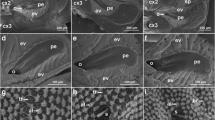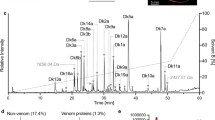Abstract
The Dufour glands of workers ofEciton burchelli contain a mixture of small quantities of oxygenated compounds, some of which are derived from terpenes, and C17-C25 hydrocarbons. The secretion of the Dufour glands of soldiers was either similar to that of workers, with geranylacetone a significant component, or they contained geranyllinalool in large amounts. The glands of workers and soldiers ofLabidus praedator andLabidus coecus contained (E)-β-ocimene, a new substance for the Dufour glands of ants. 4-Methyl-3-heptanone was the dominant compound in the mandibular glands ofE. burchelli andL. coecus. Skatole and indole were found in the gasters ofL. praedator, and skatole was present in the venom glands of some soldiers ofE. burchelli.
Similar content being viewed by others
References
Attygalle, A.B. andMorgan, E.D. 1982. Structures of homofamesene and bishomofarnesene isomers fromMyrmica ants.J. Chem. Soc. Perkin I 1982:949–951.
Attygalle, A.B., andMorgan, E.D. 1984. Chemicals from the glands of ants.Chem. Soc. Rev. 13:245–278.
Bagnères, A.C., andMorgan, E.D. 1991. The postpharyngeal glands and the cuticule of Formicidae contain the same characteristic hydrocarbons.Experientia 47:106–111.
Bagnéres, A.G., Billen, J., andMorgan, E.D. 1991. Volatile secretion of Dufour gland of workers of an army antDorylus (Anomma) molestus.J. Chem. Ecol. 17:1633–1639.
Baker, R., Coles, H.R., Edwards, M., Evans, D.A., Howse, P.E., andWalmsley, S. 1981. Chemical composition of the frontal gland secretion ofSyntermes soldiers (Isoptera, Termitidae).J. Chem. Ecol. 7:135–145.
Bernardi, R., Cardani, C., Ghiringhelli, D., Selva, A., Baggini, A., andPavan, M. 1967. On the components of the secretion of mandibular glands of the antLasius (Dendrolasius) fuliginosus.Tetrahedron Lett. 40:3893–3896.
Billen, J. 1985. Comparative ultrastructure of the poison and Dufour glands in Old and New World army ants (Hymenoptera, Formicidae).Actes Coll. Insectes Soc. 2:17–26.
Billen, J. 1992. Origin of the trail pheromone in Ecitoninae: A behavioural and morphological examination, pp. 203–209,in J. Billen (ed.). Biology and Evolution of Social Insects, Leuven University Press, Leuven.
Billen, J.P.J., Evershed, R.P., Attygalle, A.B., Morgan, E.D., andOllett, D.G. 1986. Contents of the Dufour glands of workers of three species ofTetramorium.J. Chem. Ecol. 12:669–685.
Blum, M.S., andPortocarrero, C.A. 1964. Chemical releasers of social behavior. IV. The hindgut as the source of the odor trail pheromone in the Neotropical army ant genusEciton.Ann. Entomol. Soc. Am. 57:793–794.
Brand, J.M., Blum, M.S., Lloyd, H.A., andFletcher, D.J.C. 1974. Monoterpene hydrocarbons in the poison gland secretion of the antMyrmicaria natalensis (Hymenoptera: Formicidae).Ann. Entomol. Soc. Am. 67:525–526.
Dawson, G.W., Griffiths, D.C., Pickett, J.A., Plumb, R.T., Woodcock, C.M., andZhang, Z.-N. 1988. Structure-activity studies on aphid alarm pheromone derivatives and their field use against transmission of barley yellow dwarf virus.Pestic. Sci. 22:17–30.
Demole, E., andLederer, E. 1958. Isolement du phytol, de l'isophytol et du geranyl-linalool à partir de l'essence concrète de Jasmin.Bull. Soc. Chim. Fr. 1958:1128–1137.
Franks, N.R. 1985. Reproduction, foraging efficiency and worker polymorphism in army ants, pp. 91–107,in B. Hölldobler and M. Lindauer (eds.). Experimental Behavioural Ecology and Sociobiology (Fortschritte der Zoologie, Nr 31; B.). Sinauer Assoc., Sunderland, Massachusetts.
Franks, N.R. 1989. Thermoregulation in army ant bivouacs.Physiol. Entomol. 14:397–404.
Franks, N.R., andHölldobler, B. 1987. Sexual competition during colony reproduction in army ants.Biol. J. Linn. Soc. 30:229–243.
Friedman, L., andShani, A. 1974. Halopolycarbon homologation,J. Am. Chem. Soc. 96:7101–7103.
Gotwald, W.H. 1982. Army ants, pp. 157–254,in H.R. Hermann (ed.). Social Insects, Vol. 4. Academic Press, New York.
Hölldobler, B., andEngel, H. 1978. Tergal and sternal glands in ants.Psyche 85:285–330.
Hölldobler, B., andWilson, E.O. 1990. The Ants. Springer, Berlin.
Jackson, B.D., Keegans, S.J., Morgan, E.D., Cammaerts, M.C., andCammaerts, R. 1990. Trail pheromone of the antTetramorium meridionale.Naturwissenschaften 77:294–296, 452.
Law, J.H., Wilson, E.O., andMcCloskey, J.A. 1965. Biochemical polymorphism in ants.Science 149:544–546.
Morgan, E.D. 1990. Preparation of small-scale samples from insects for chromatography.Anal. Chim. Acta. 236:227–235.
Morgan, E.D., andWadhams, L.J. 1972. Gas chromatography of volatile compounds in small samples of biological materials.J. Chromatogr. Sci. 10:528–529.
Rettenmeyer, C.W.,Chadab-Crepet, R.,Naumann, M.G., andMorales, L. 1983. Comparative foraging by neotropical army ants, pp. 59–73,in P. Jaisson (ed.). Social Insects in the Tropics, Vol. 2. Université Paris-Nord.
Schildknecht, H. 1976. Chemical ecology—a chapter of modern natural products chemistry.Angew. Chem. Int. Ed. Engl. 15:214–222.
Schneirla, T.C. 1971. Army Ants: A Study in Social Organization. W.H. Freeman, San Francisco. 349 pp.
Sutton, C.J., Keegans, S.J., Kirk, W.D.J., andMorgan, E.D. 1992. Floral volatiles ofVicia faba.Phytochemistry 31:3427–3428.
Topoff, H. 1972. The social behaviour of army ants.Sci. Am. 227:71–79.
Torgerson, R.L., andAkre, R.D. 1970. Interspecific responses to trail and alarm pheromones by New World army ants.J. Kans. Entomol. Soc. 43:395–404.
Watkins, J.F. 1976. The identification and distribution of New World army ants (Dorylinae: Formicidae). Markham Press Fund of Baylor University Press, Waco, Texas. 102 pp.
Watkins, J.F., Cole, T.W., andBaldridge, R.S. 1967. Laboratory studies on interspecies trail following and trail preference of army ants (Dorylinae).J. Kans. Entomol. Soc. 40:146–151.
Whelden, R.M. 1963. Anatomy of adult queen and workers of army antsEciton burchelli Westwood andEciton hamatum Fabricus.J. N.Y. Entomol. Soc. 71:14–30, 90–115, 158–178, 246–261.
Wilson, E.O. 1958. The beginnings of nomadic and group-predatory behavior in the ponerine ants.Evolution 12:24–31.
Author information
Authors and Affiliations
Rights and permissions
About this article
Cite this article
Keegans, S.J., Billen, J., Morgan, E.D. et al. Volatile glandular secretions of three species of new world army ants,Eciton burchelli, Labidus coecus, andLabidus praedator . J Chem Ecol 19, 2705–2719 (1993). https://doi.org/10.1007/BF00980702
Received:
Accepted:
Issue Date:
DOI: https://doi.org/10.1007/BF00980702




